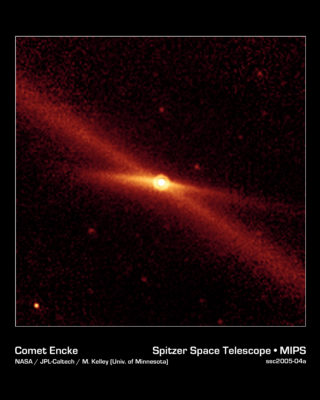Taurids: an unusual meteor shower
Among all meteor showers, Taurids are very specific: their activity period is quite long, and overtakes the Anthelion source for a few months. The radiant of the Southern and Northern banches are also very diffuse compared to classical radiants. And meteoroids that gives birth to Taurid meteors can be large, and even very large (sometimes meter-sized). The source of this unusual shower is sometimes thought to be 2P/Encke comet (the comet with the shortest period of the Solar system. It seems that it actually find its roots in a much more dramatic event that happened 10-20 000 years ago, when a giant comet (hundred kilometer wide) fragmented in the inner Solar system (Clube & Napier, 1984), giving birth to numerous objects, of which 2P/Encke (Figure 1) is a part.

An hypothetical source of Near Earth Asteroid
Furthermore, Taurids also displays dramatic events. Some years, number of meteors and their brightness increases during the period extending from end of October to beginning of November. According to (Asher & Clube, 1993) theory, this would be due to numerous debris issued from the giant comet desintegration trapped in the 7:2 resonance with Jupiter: the Taurid Resonant Swarm. When the Earth passes close to such meteoroid swarm, which is to happen in 2022, number of meteors as well as their size are enhanced. Which result in more meteors, and more fireballs. This feature has been observed in the past, especially in 1995, 2005, 2015 & 2019. This last Taurid swarm was well recorded (Spurny et al., 2017), and some newly discovered asteroids seemed to be part of the resonant swarm. So not only are we meant to observe brighter meteors, but maybe we will be able to detect more Near Earth Asteroids resulting from the giant comet fragmentation trapped in the resonant swarm.
According to Denis Vida, 2022 could also be a good year to detect such NEO: he simulated the hypothetical Taurid swarm over the past and coming months (see below):
Results of the model show “the hypothetical asteroids should be very bright (mag +19 and brighter), and reasonably well concentrated in the sky for a few days around Oct 30“, he says on MPML (Minor Planet Mailing List) on October 3. This is why Taurid Swarm could also lead to new Near Earth Asteroid discovers. And imagine one of them would enter the Earth atmopshere at that period…
Bibliography
- Asher, D., Clube, S. V. M., and Steel, D. I., 1993. Asteroids in the Taurid Complex. MNRAS, vol. 264, pp.93-105.
- Clark, D., Wiegert, P., and Brown, P. G., 2019. The 2019 Taurid resonant swarm: prospects for ground detection of small NEOs. MNRAS Letters, vol. 487, pp. L35-L39.
- Clube, S. V. M., Napier, W. M., 1984. The microstructure of terrestrial catastrophism. MNRAS, vol. 211, pp. 953-968.
- Spurny, P., Borovicka, J., Mucke, H. and Svoren, J., 2017. Discovery of a new branch of the Taurid meteoroid stream as a real source of potentially hazardous bodies. A&A, vol. 605, A68.




 You saw something bright and fast? Like a huge shooting star? Report it: it may be a fireball.
You saw something bright and fast? Like a huge shooting star? Report it: it may be a fireball.  You counted meteors last night? Share your results with us!
You counted meteors last night? Share your results with us!  You took a photo of a meteor or fireball? You have a screenshot of your cam? Share it with us!
You took a photo of a meteor or fireball? You have a screenshot of your cam? Share it with us!  You caught a meteor or fireball on video? Share your video with us!
You caught a meteor or fireball on video? Share your video with us!